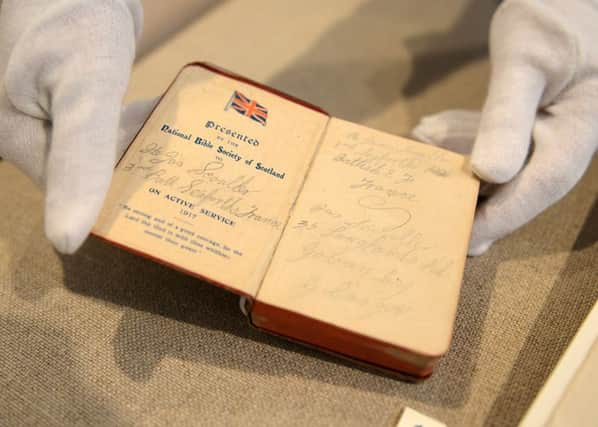First World War memories are still honoured


The centenary of the First World War continues to be marked at major milestone anniversaries, such as recent events in connection with Gallipoli and also the Gretna rail disaster.
There is the international First World War Centenary Partnership, led by the Imperial War Museum, and WWI Scotland – steered by the First World War Commemorations Panel in Scotland – as well as a host of local programmes run by societies, organisations and institutions all over the country.
Advertisement
Hide AdAdvertisement
Hide AdThe commemorations are local, regional, national and international in their scale, but all have things in common, particularly the shared experience and memory they represent.
Next of Kin is a touring exhibition project which centres on revealing the personal experiences of Scottish families during the First World War and, in particular, the way in which physical objects served as a way of preserving memories and associations.
Through the personal effects of the servicemen and women passed on to their families and down through generations, the exhibition provides unique insights into their poignant stories of separation and sacrifice.
There are some exceptional items in Next of Kin, such as the bible which belonged to Paisley-born Private Scouller. A German soldier, Herr Altrogge, sat with him as he died from his wounds at the Battle of Cambrai. Herr Altrogge posted the bible back to Scotland with a vivid account of Scouller’s last moments. The timing is most poignant: the letter is dated 1938, by which time Herr Altrogge would have known that another global conflict was inevitable.
However, much of the collections of objects, whilst clearly of great significance to the individuals and families directly connected to them, are quite generic in their production and distribution through the country.
George Buchanan of the Seaforth Highlanders was just one of more than 20,000 British troops who lost their lives at the Battle of Loos, in September-October 1915. A third of those who fell were from Scottish units. Buchanan, a railway plate layer from Bathgate, was killed on the first day of the battle. Shown in the exhibition are a postcard home dated 11 September, a letter from the chaplain notifying the family of his death on the first day of the battle just a fortnight later and the memorial plaque, or “dead man’s penny”, sent to Buchanan’s next of kin by the British government on behalf of the King, as was the case with all servicemen killed in action.
Again, Buchanan was one of many casualties, and so these objects reflect more than the single story of George Buchanan: there was a common experience of fear, anxiety and often loss, widely shared, but personal nonetheless. Although Buchanan’s effects happen to be in the national collections, there is material like this in local collections and in private family archives all over the country.
The Next of Kin touring programme is already proving this. The exhibition was first shown in the National War Museum in Edinburgh Castle, featuring collections from National Museums Scotland. It is now at Dumfries Museum, where the local collections and contributions from residents have been added to and complement the core display. The stories of the brave men of Mennock or of the Sanders twins, of whom only one survived the conflict, are unique and yet familiar, the medals still held with pride by the family.
Advertisement
Hide AdAdvertisement
Hide AdAs the exhibition tours, the other host venues – in south Ayrshire, Hawick, Hamilton, Aberdeenshire, Inverness, Perth and Orkney – will develop additional content using objects and stories related to their respective local areas. The results of these additional contributions will be shown in the exhibition displays and they will also be preserved long-term in digital form, meaning that there is a lasting legacy.
Meanwhile, learning activities exploring the exhibition themes will take place at each venue. School and community groups will be able to interact with a bespoke handling collection made up of original and replica objects. There is also an associated training programme to develop new skills among the participating organisations.
Next of Kin will finish in Dumfries on Sunday 20 June. However, the huge level of interest and the number people coming forward with their objects and stories have helped ensure that Dumfries Museum has ample material and inspiration to continue to display First World War materials and deliver programme activities throughout the centenary period. The next venue will be Rozelle House in Ayr, where the exhibition will run from 4 July to 28 September.
As the First World War passes from living memory, Next of Kin demonstrates the importance of objects and collections in the preservation and understanding of national memory, both that which is shared and universal, and that which is personal and unique.
• Jo Sohn-Rethel is the First World War centenary project co-ordinator at National Museums Scotland www.nms.ac.uk